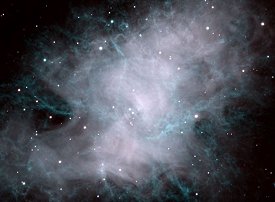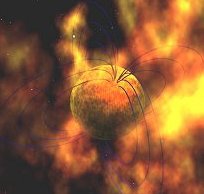|
Using a new form of matter
researchers are bringing astrophysics from deep space right into
their laboratories.
by Dr Tony Phillips
Neutron stars are weird.
They're about the same size as Manhattan Island
yet more massive than the Sun. A teaspoonful of one would weigh
about a billion tons. On the outside, neutron stars are brittle.
They are covered by an iron-rich crust. On the inside, they are
fluid. Each one harbours a sea of neutrons - the debris from atoms
crushed by a supernova explosion. The whole ensemble rotates hundreds
of times each second, and so spawns powerful quantum tornadoes within
the star.
You probably wouldn't want one on your desktop....
That is, unless you're an experimental physicist.
Neutron stars and their cousins, white dwarfs and black holes,
are extreme forms of matter that many scientists would love to tinker
with - if only they could get one in their lab. But how? Researchers
experimenting with a new form of matter called Bose-Einstein condensates
may have found a way.
Bose-Einstein condensates (BECs) are matter waves formed when very
cold atoms merge to become a single "quantum mechanical blob." They
contain about ten million atoms in a droplet 0.1 mm across. Physicists
Eric Cornell (NIST), Carl Wieman (University of Colorado) and Wolfgang
Ketterle (MIT) - who shared the 2001 Nobel Prize in Physics -
created the first ones from vaporous gases in 1995.
In most ways, BECs and neutron stars are dissimilar. BECs are 100,000
times less dense than air, and they are colder than interstellar
space. Neutron stars, on the other hand, weigh about 100 million
tons per cubic centimetre, and their insides are 100 times hotter
than the core of the Sun. So what do they have in common? Both are
superfluids - that is, liquids that flow without friction or viscosity.

more
Neutron stars
are formed in supernova explosions. This supernova remnant
(known as the Crab Nebula) harbors one that spins 30 times
every second.
|
Perhaps the best-known example of a
superfluid is helium-4 cooled to temperatures less than 2.2o
K (-271o C). If you held in your hand a well-insulated
cup of such helium and slowly rotated the cup, the slippery helium
inside wouldn't rotate with it.
Yet superfluids can rotate.
And when they do, weird things happen. "Superfluids cannot turn
as a rigid body - in order to rotate, they must swirl," explains
Ketterle. Among physicists he would say that "the curl of the velocity
field must be zero." This basic physics holds for BECs and neutron
stars alike.
In 2001, following similar experiments
in 1999 by researchers in Colorado and France, Ketterle and his
colleagues at MIT decided to spin a BEC and see what would happen.
Ketterle says he didn't have neutron stars in mind when he did the
experiment: "BECs are a new form of matter, and we wanted to learn
more about them. By rotating BECs, we force them to reveal their
properties." Simulating the inside of a weird star was to be an
unintended spin-off.
Ketterle's team shone a rotating laser
beam on the condensate, which was held in place by magnets. He compares
the process to "stroking a ping-pong ball with a feather until it
starts spinning." Suddenly, a regular array of whirlpools appeared.
"It was a breathtaking experience when
we saw those vortices," recalls Ketterle. Researchers had seen such
whirlpools before (in liquid helium and in BECs) but never so many
at once. The array of quantum tornadoes was just the sort of storm
astronomers had long-suspected might swirl within neutron stars.

more
Arrays of vortices
that form in spinning BECs resemble the
insides of neutron stars.
|
No one has ever seen superfluid vortices
inside a neutron star, but we have good reason to believe they exist:
Many neutron stars are pulsars - that is, they emit a beam of radiation
as they spin. The effect is much like a light house: we see a flash
of light or radio waves each time the beam sweeps by. The pulses
arrive at intervals so impressively regular that they rival atomic
clocks. In fact, when Jocelyn Bell Burnell and Tony Hewish discovered
pulsars in 1967, they wondered if they were receiving intelligent
signals from aliens! Sometimes, though, pulsars "glitch" like a
cheap wristwatch that suddenly begins to run too fast. The glitches
are likely due to superfluid vortices forming or decaying within
the star, or perhaps vortices brushing against the star's crust.
The swirling vortices
in BECs offer scientists an opportunity to study such processes
first-hand - without burrowing into a distant star.
The possibilities don't
end there: "If the condensed
atoms [in a BEC were to] attract each other, then the whole condensate
can collapse," Ketterle adds. "People have actually predicated that
the physics is the same as that of a collapsing neutron star. So
it's one way, maybe, to realize a tiny neutron star in a small vacuum
chamber."
Small, confined and tame - a pet
neutron star? It sounds far-fetched, yet researchers are learning
to make BECs collapse in real-life experiments.

Credit: NASA
An artist's
concept of a magnetized neutron star in space.
|
BECs are formed with the aid of magnetic
traps. Carl Wieman and colleagues at NIST have discovered that atoms
inside a BEC can be made to attract or repel one another by "tuning"
the magnetic field to which the condensate is exposed. Last year,
they tried both: First, they made a self-repelling BEC. It expanded
gently, as expected. Then, they made a mildly self-attracting BEC.
It began to shrink - again as expected - but then it did something
wholly unexpected.
It exploded!
Many of the atoms in the BEC flew outward, some
in spherical shells, others in narrow jets. Some of the ejecta completely
disappeared - a lingering mystery. Some remained as a smaller core
at the position of the original condensate.
To an astrophysicist, this sounds remarkably like
a supernova explosion. Indeed, Wieman et al dubbed it a "Bosenova"
(pronounced "bose-a-nova"). In fact, the explosion liberated only
enough energy to raise the temperature of the condensate 200 billionths
of a degree. A real supernova would have been 1075 times
more powerful. But you have to start somewhere.
If researchers eventually do craft miniature neutron
stars, they might learn to make white dwarfs and black holes as
well. Such micro-stars pose no danger to Earthlings. They are simply
too small and their gravity too feeble to gobble objects around
them. But such pets would no doubt be popular among physicists
and astronomers.
Personally, I think I'll stick to dogs.
|
